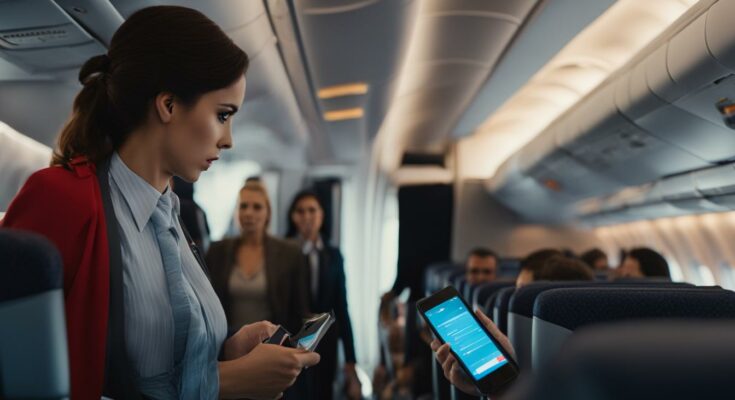Before packing for your next flight, you may be wondering how many power banks are allowed on flights. As regulations and restrictions around power banks on airplanes continue to change, it’s essential to stay informed to avoid any complications at the airport.
In this section, we will provide you with a comprehensive guide on power bank restrictions on flights, including how many power banks you are allowed to carry on a plane and the rules you need to follow when traveling with power banks.
Key Takeaways
- It’s important to know the regulations and restrictions around power banks on flights before traveling.
- Airlines and transportation security agencies have set guidelines for carrying power banks on flights.
- There are restrictions on the size, capacity, and battery types of power banks allowed on flights.
- Following simple tips for traveling with power banks can make your journey stress-free.
- There are alternative options available for charging your devices while traveling if you are concerned about power bank restrictions.
Understanding Power Bank Regulations
Before you pack your power banks for your flight, it’s essential to understand the regulations set by airlines and transportation security agencies. Knowing the guidelines provided by airlines and the TSA will help you comply with the rules.
Airline Regulations for Power Banks: Each airline has different rules regarding the number, size, and capacity of power banks allowed on flights. It’s best to check with your specific airline before packing your power banks. Most airlines follow similar restrictions imposed by the TSA.
Power Bank TSA Guidelines: The Transportation Security Administration (TSA) has specific guidelines for carrying power banks on planes. As per the TSA, only power banks with a capacity of fewer than 100 watt-hours (Wh) or 27,000 milliampere-hours (mAh) are allowed in carry-on bags. Power banks exceeding these limits must be stored in checked luggage.
| Power Bank Capacity | Allowed in Carry-On Luggage | Allowed in Checked Luggage |
|---|---|---|
| Less than 100Wh or 27,000mAh | ✅ | ✅ |
| 100-160Wh or 27,000-46,080mAh (with airline approval) | ✅ | ✅ |
| Over 160Wh or 46,080mAh | ❌ | ✅ |
Power Bank Travel Restrictions: It’s essential to note that power banks must be carried in your carry-on bag rather than checked luggage. The FAA and the TSA require that all lithium-ion batteries, including power banks, must be carried in the cabin of the aircraft and not checked in case of any fire hazards.
By understanding the regulations and guidelines for power banks on flights, you can ensure a hassle-free journey and avoid any complications at the airport.
Carry-On Limits for Power Banks
When traveling with power banks, it’s essential to understand the size and capacity restrictions imposed by airlines to ensure they comply with regulations. Compliance with these guidelines is crucial to avoid any issues that may arise at the airport.
The carry-on limits for power banks can vary depending on the airline and the country of destination. However, there are general guidelines that apply across the board. According to the TSA, power banks must be carried in carry-on baggage and not checked-in luggage.
The size limit for power banks for air travel is 100 watt-hours (Wh) per battery. Anything above this limit is prohibited. Power banks with a capacity of more than 100 Wh can be carried, but the airline’s approval is required.
Power Bank Size Limits for Air Travel
The table below shows the size limits for carrying power banks on some popular airlines:
| Airline | Power Bank Size Limit |
|---|---|
| American Airlines | 100Wh per battery |
| Delta Airlines | 100Wh per battery |
| United Airlines | 100Wh per battery |
Note: Always check with your specific airline for the most up-to-date information regarding power bank carry-on limits.
It’s important to remember that any power bank that does not comply with these guidelines must be left at the airport or surrendered to airport authorities. As such, it’s best to check these guidelines before you travel and make sure that your power banks comply with the regulations set forth by your airline.
By adhering to these guidelines, you can travel with your power banks with ease, ensuring that you have enough power to keep your devices charged throughout your journey.
Battery Restrictions for Power Banks
When it comes to power banks, not all batteries are created equal. While some battery types are considered safe for air travel, others are restricted due to the potential risk of fire or explosion. Therefore, it’s crucial to understand the specific battery restrictions for power banks before you board a flight.
In general, power banks with lithium-ion (Li-ion) batteries are allowed on planes as carry-on items. However, power banks with lithium-metal batteries are prohibited on both carry-on and checked baggage due to their higher risk of fire.
It’s also important to note that the capacity of the power bank plays a role in whether it’s allowed on a plane. Power banks with a capacity greater than 100 watt-hours (Wh) or 27,000 milliampere-hours (mAh) must be explicitly approved by the airline before boarding.
To determine the watt-hours of your power bank, multiply the battery voltage (V) by the ampere-hours (Ah). For example, a power bank with a 3.7V battery and a 10,000mAh capacity would have a watt-hour rating of 37Wh.
Note: These regulations may vary depending on the airline and the country you are traveling to or from. Always check with the airline’s website or the TSA website for the most up-to-date information.
Tips for Traveling with Power Banks
If you plan on traveling with power banks, it’s essential to be aware of the power bank travel restrictions set by airlines and the TSA. Failure to comply with these guidelines can result in confiscated power banks or even delays in your travel plans. Here are some tips to help you travel with power banks stress-free:
Pack Your Power Banks in Your Carry-On Luggage
It’s always best to pack your power banks in your carry-on luggage rather than checking them in. This way, you can easily access your power banks during your flight and ensure they are in good condition. Some airlines may even require you to carry your power banks in your carry-on luggage due to safety reasons.
Check the Capacity of Your Power Banks
Before traveling, make sure to check the capacity of your power banks. The TSA allows power banks with a capacity of 100 watt-hours (Wh) or less in your carry-on luggage. If your power banks have a higher capacity, you may need to check them in or obtain approval from the airline beforehand.
Keep Your Power Banks Protected
When packing your power banks, make sure to keep them protected. Use a sturdy case or cover to prevent any damage or accidental activation during your travels. Avoid packing your power banks with other sharp or heavy objects that could cause damage.
Charge Your Power Banks Before Your Flight
Make sure to charge your power banks before boarding your flight. This way, you can use them immediately when needed during your travels. Some airports may have restrictions on charging your power banks, so it’s always best to have them fully charged beforehand.
Stay Up-to-Date on Power Bank Regulations
It’s essential to stay up-to-date on power bank regulations to ensure a smooth travel experience. Check the TSA and your airline’s website for the latest guidelines and restrictions regarding power banks. This way, you can avoid any issues at the airport and ensure a stress-free journey.
Check-In vs. Carry-On: Which is Better?
If you’re wondering whether to pack your power bank in your carry-on luggage or check it in, there are advantages and disadvantages to both options.
Carry-On Luggage
Carrying your power bank in your carry-on luggage can be a convenient option, as you have easy access to it throughout your journey. However, there are restrictions on the size and capacity of power banks that you can bring on board.
According to TSA guidelines, any power bank exceeding 100 watt-hours (Wh) or 30,000 milliampere-hours (mAh) must be approved by the airline before boarding. Additionally, power banks must be carried in your carry-on luggage, not in your checked-in bag.
| Pros | Cons |
|---|---|
|
|
Checked-In Luggage
Checking your power bank in your luggage can be a convenient option if you have larger power banks that exceed the carry-on limits. However, there are risks associated with checked-in luggage, such as damage or loss during transportation.
It’s important to note that some airlines may prohibit power banks in checked-in luggage, so it’s crucial to check with your airline before packing your power bank in your checked-in bag.
| Pros | Cons |
|---|---|
|
|
Ultimately, the decision to pack your power bank in your carry-on or checked-in luggage depends on the size and capacity of your power bank and your personal preference. Ensure to check with your airline for specific regulations to avoid any complications at the airport.
Power Bank Alternatives for Travel
If you are concerned about the restrictions and regulations surrounding power banks, there are alternative options available for charging your devices while traveling.
Battery Cases
Battery cases are an excellent power bank alternative for those looking for a compact and convenient option. These cases are designed to fit your phone and provide an extra charge without taking up too much space.
Solar Chargers
Solar chargers are an eco-friendly and reliable option for charging your devices while outdoors. These devices absorb energy from the sun and convert it into power to charge your devices.
Portable Chargers
Portable chargers are a great alternative to power banks. They offer a high-capacity charge and come in various sizes to fit your travel needs.
Wall Chargers
Wall chargers may seem like a traditional option, but they are still a convenient way to charge your phone. Most airports provide wall outlets, making it easy to charge your device while waiting for your flight.
Wireless Chargers
Wireless chargers are another convenient option for charging your device. These chargers use electromagnetic fields to transfer power to your device, eliminating the need for cables.
Remember to always have a backup plan when traveling. While power banks are still a popular option, having an alternative ensures you can always stay connected while on the go.
Conclusion
Traveling with power banks can be stress-free if you know the regulations and restrictions set by airlines and transportation security agencies. Before your flight, familiarize yourself with the carry-on limits, battery restrictions, and guidelines provided by your specific airline and the TSA.
Remember to pack your power banks in your carry-on luggage and avoid checking them in. If you are concerned about the restrictions, consider alternative options for charging your devices while traveling.
Overall, following these tips and guidelines will ensure a smooth and hassle-free travel experience. Always prioritize safety and compliance when it comes to carrying power banks on flights. Happy travels!
FAQ
How many power banks are allowed on flights?
The number of power banks you are allowed to carry on a flight may vary depending on the airline and the destination. It is recommended to check with your specific airline for their regulations.
What are the regulations for power banks on flights?
Airlines and transportation security agencies, such as the TSA, have guidelines in place for power banks. These guidelines typically include restrictions on size, capacity, and battery type. Make sure to comply with these regulations to avoid any issues at the airport.
Are there limits on carrying power banks in your carry-on luggage?
Yes, there are limits on carrying power banks in your carry-on luggage. The size and capacity restrictions may vary, so it’s important to check with your airline for their specific guidelines.
What are the battery restrictions for power banks?
Battery restrictions for power banks may vary depending on the airline and destination. It’s crucial to be aware of the specific battery types that are allowed on flights. Check with your airline or transportation security agency for more information.
What are some tips for traveling with power banks?
When traveling with power banks, it’s recommended to pack them in your carry-on luggage and keep them easily accessible. Ensure they are fully charged before your flight and avoid packing them with other electronic devices. It’s also advisable to pack them in a protective case or cover.
Is it better to carry power banks in carry-on or check-in luggage?
Carrying power banks in your carry-on luggage is generally recommended. This allows you to keep them with you during the flight and reduces the risk of damage or loss. However, it’s important to comply with the carry-on limits set by your airline.
Are there any alternatives to power banks for travel?
If you are concerned about the restrictions and regulations surrounding power banks, there are alternative options available for charging your devices while traveling. These include portable chargers, solar chargers, and charging stations at airports and other public places.




